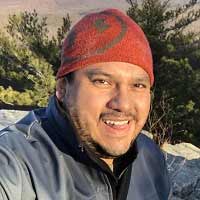Online Education in the Time of COVID-19
During the COVID-19 pandemic, over half-a-million students in the US have been affected by a growing number of university closures. That number will rise—and it could end up saving lives.
“Encouraging people to work and study from home helps stop transmission of the virus,” says Rene Najera, DrPH, an epidemiologist with the Fairfax County Health Department. “If they stay home, then their risk of becoming infected or—if they are infected—their risk of infecting others goes down.”
Containment strategies like this don’t always have the desired effect, though. Closing elementary-level schools can lead to health workers needing to split their time between caring for patients and caring for their own children. And, in extreme cases, quarantine can go nightmarishly wrong. Making the transition from on-campus to online learning as smooth as possible can reduce the disruption felt by the public.
“As for successful containment strategies, there are many,” Dr. Najera says. “I think what we did with SARS in 2003 is a good example. SARS had the capacity to become what this coronavirus has done. (SARS is also a coronavirus.) But the world moved very, very quickly to contain it at a very early stage. The result was spread only to a handful of countries.”
Schools Adapting to a Strategy of Social Distancing
The education world is moving as quickly as it can to make the transition. Coursera, an online education platform, is making all of its 3,800 courses available for free to any university impacted by COVID-19. The US Department of Education has allowed colleges to introduce distance education programs without needing to acquire the usual accreditation and certification. Schools and students are getting a crash course in online education.
It’s not just at the collegiate level, either. As schools close around the world, UNESCO is recommending the use of distance learning programs to limit the disruption to education. Online education has come a long way in the last decade, and it’s about to be catapulted into the global mainstream. The lessons learned during this massive experiment will have ripple effects for students, teachers, and universities for years to come.
A Broadened Infrastructure for Online Learning
Once a university knows that it’s capable of transitioning to online learning when necessary, that flexibility can be applied in other times of heightened danger. A normal flu season, for instance, causes between 12,000 and 60,000 deaths per year in the US.
“During a normal flu season, allowing people to stay home when levels of influenza reach a peak in the community helps,” Dr. Najera says.
It’s also possible that students who get their first taste of online learning might warm to the idea in ways they wouldn’t have before. As noted by The Economist, there’s a precedent for such a line of thinking: a London Underground strike in 2014. That strike didn’t close all the subway lines in the city, but it did force commuters to plan new routes to their destinations. Researchers from Oxford and Cambridge found that 5 percent of passengers continued to use their new routes even after all lines were open again. Furthermore, the economic gains created by those travelers adopting new ways of getting to work outweighed the cost of the disruption of service caused by the strike. Sometimes, a little disruption can help find a more efficient outcome.
But COVID-19 isn’t the only pandemic spreading throughout the world. Fear, irrationality, and misinformation can be just as dangerous. According to Dr. Najera, the best way to combat those factors is through science-based education.
“Understanding germ theory, evolution, and chemistry can go a long way to help us understand risk in the world we live in,” Dr. Najera says. “I get on planes because I understand how lift works to keep very heavy objects up in the air. I vaccinate my daughter because I understand relative risk and odds ratios. If I could sit everyone down right now and give them a two-hour lecture on viruses and disease transmission, we could probably stop the hoarding of toilet paper. Just two hours… with a quiz at the end.”
As long as that lecture’s online, that is.
Editor’s Note: see our curated list of online learning resources and best practices for professors and students moving to an online learning model.
Meet the Expert: Rene Najera, DrPH

Dr. Rene Najera works in George Mason University’s Department of Global and Community Health and serves as an epidemiologist at the Fairfax County Health Department in Virginia. He earned his Doctor of Public Health (DrPH) from the Johns Hopkins Bloomberg School of Public Health in 2018. His dissertation focused on the applying epidemiological and social network analysis methods to social problems, such as the epidemic of gun violence in Baltimore City.
Previously, Dr. Najera worked as an influenza surveillance coordinator for the State of Maryland and the Maryland Department of Health. In that position, he conducted public health surveillance of influenza and other communicable diseases, and, when necessary, aided in outbreak investigations. Dr. Najera introduced new ways of conducting disease surveillance, including the use of social media, which, during the H1N1 pandemic, provided critical information to improve the public health response. His blog, Epidemiological, is one of the most highly-trafficked epidemiology blogs on the internet.
